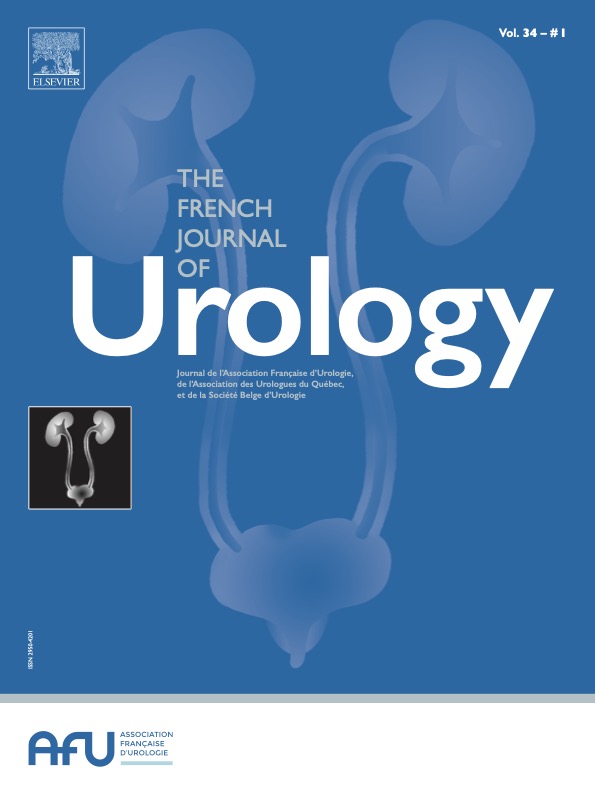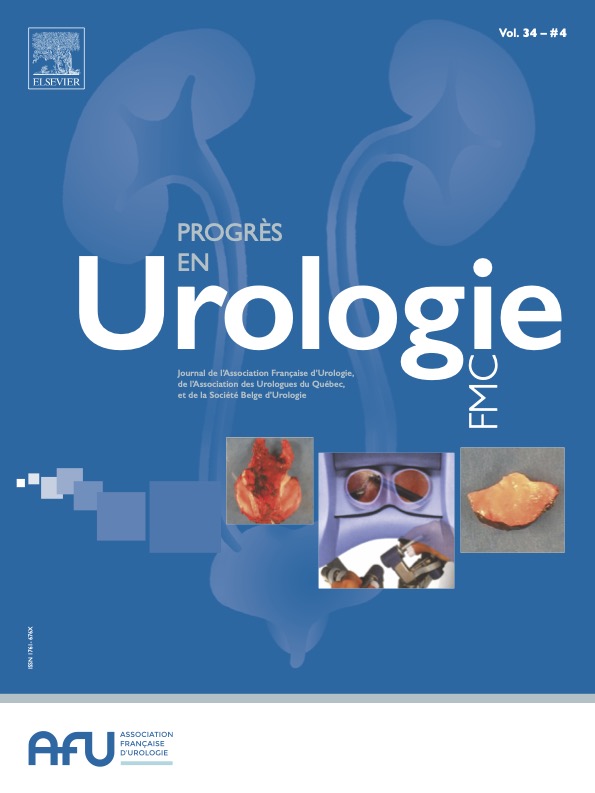| Ellerkmann R.M., Cundiff G.W., Melick C.F., Nihira M.A., Leffler K., Bent A.E. Correlation of symptoms with location and severity of pelvic organ prolapse Am J Obstet Gynecol 2001 ; 185 : 1332-1337discussion 7-8.
[inter-ref] |
|
| Digesu G.A., Chaliha C., Salvatore S., Hutchings A., Khullar V. The relationship of vaginal prolapse severity to symptoms and quality of life BJOG 2005 ; 112 : 971-976 [cross-ref] |
|
| Burrows L.J., Meyn L.A., Walters M.D., Weber A.M. Pelvic symptoms in women with pelv’c organ prolapse Obstet Gynecol 2004 ; 104 : 982-988 [cross-ref] |
|
| Miedel A., Tegerstedt G., Maehle-Schmidt M., Nyren O., Hammarstrom M. Symptoms and pelvic support defects in specific compartments Obstet Gynecol 2008 ; 112 : 851-858 [cross-ref] |
|
| Fatton B., Nadeau C. Urinary incontinence and genital prolapse J Gynecol Obstet Biol Reprod 2009 ; 38 : S239-S251 [inter-ref] |
|
| Slieker-ten Hove M.C., Pool-Goudzwaard A.L., Eijkemans M.J., Steegers-Theunissen R.P., Burger C.W., Vierhout M.E. The prevalence of pelvic organ prolapse symptoms and signs and their relation with bladder and bowel disorders in a general female population Int Urogynecol J Pelvic Floor Dysfunct 2009 ; 20 : 1037-1045 [cross-ref] |
|
| Rozet F., Mandron E., Arroyo C., Andrews H., Cathelineau X., Mombet A., et al. Laparoscopic sacral colpopexy approach for genito-urinary prolapse: experience with 363 cases Eur Urol 2005 ; 47 : 230-236 [cross-ref] |
|
| Costantini E., Lazzeri M., Bini V., Del Zingaro M., Zucchi A., Porena M. Burch colposuspension does not provide any additional benefit to pelv’c organ prolapse repair in patients with urinary incontinence: a randomized surgical trial J Urol 2008 ; 180 : 1007-1012 [cross-ref] |
|
| Borstad E., Abdelnoor M., Staff A.C., Kulseng-Hanssen S. Surgical strategies for women with pelvic organ prolapse and urinary stress incontinence Int Urogynecol J 2010 ; 21 : 179-186 [cross-ref] |
|
| Hviid U., Hviid T.V., Rudnicki M. Porcine skin collagen implants for anterior vaginal wall prolapse: a randomised prospective controlled study Int Urogynecol J 2010 ; 21 : 529-534 [cross-ref] |
|
| Colombo M., Vitobello D., Proietti F., Milani R. Randomised comparison of Burch colposuspension versus anterior colporrhaphy in women with stress urinary incontinence and anterior vaginal wall prolapse BJOG 2000 ; 107 : 544-551 [cross-ref] |
|
| Colombo M., Maggioni A., Scalambrino S., Vitobello D., Milani R. Surgery for genitourinary prolapse and stress incontinence: a randomized trial of posterior pubourethral ligament plication and Pereyra suspension Am J Obstet Gynecol 1997 ; 176 : 337-343 [inter-ref] |
|
| Kanasaki H., Oride A., Mitsuo T., Miyazaki K. Occurrence of pre-and postoperative stress urinary incontinence in 105 patients who underwent tension-free vaginal mesh surgery for pelvic organ prolapse: a retrospective study ISRN Obstet Gynecol 2014 ; 2014 : 643495 |
|
| Sergent F., Gay-Crosier G., Bisson V., Resch B., Verspyck E., Marpeau L. Ineffectiveness of associating a suburethral tape to a transobturator mesh for cystocele correction on concomitant stress urinary incontinence Urol 2009 ; 74 : 765-770 [inter-ref] |
|
| Shek K.L., Rane A., Goh J., Dietz H.P. Stress urinary incontinence after transobturator mesh for cystocele repair Int Urogynecol J Pelvic Floor Dysfunct 2009 ; 20 : 421-425 [cross-ref] |
|
| de Tayrac R., Gervaise A., Chauveaud-Lambling A., Fernandez H. Combined genital prolapse repair reinforced with a polypropylene mesh and tension-free vaginal tape in women with genital prolapse and stress urinary incontinence: a retrospective case-control study with short-term follow-up Acta Obstet Gynecol Scand 2004 ; 83 : 950-954 [cross-ref] |
|
| Hung M.J., Liu F.S., Shen P.S., Chen G.D., Lin L.Y., Ho E.S. Factors that affect recurrence after anterior colporrhaphy procedure reinforced with four-corner anchored polypropylene mesh Int Urogynecol J Pelvic Floor Dysfunct 2004 ; 15 : 399-406 [cross-ref] |
|
| Sentilhes L., Sergent F., Resch B., Verspyck E., Descamps P., Marpeau L. Midterm follow-up of high-grade genital prolapse repair by the trans-obturator and infracoccygeal hammock procedure after hysterectomy Eur Urol 2007 ; 51 : 1065-1072 [cross-ref] |
|
| Sergent F., Zanati J., Bisson V., Desilles N., Resch B., Marpeau L. Perioperative course and medium-term outcome of the transobturator and infracoccygeal hammock for posthysterectomy vaginal vault prolapse Int J Gynaecol Obstet 2010 ; 109 : 131-135 [cross-ref] |
|
| Liang M.L., Lin Y.H., Chang Y.L., Chang S.D. Urodynamic and clinical effects of transvaginal mesh repair for severe cystocele with and without urinary incontinence Int J Gynaecol Obstet 2011 ; 112 : 182-186 |
|
| Takahashi S., Obinata D., Sakuma T., Nagane Y., Sato K., Mochida J., et al. Tension-free vaginal mesh procedure for pelvic organ prolapse: a single-center experience of 310 cases with 1-year follow up Int J Urol 2010 ; 17 : 353-358 |
|
| Van der Ploeg J.M., Van der Steen A., Oude Rengerink K., Van der Vaart C.H., Roovers J.P. Prolapse surgery with or without stress incontinence surgery for pelvic organ prolapse: a systematic review and meta-analysis of randomised trials BJOG 2014 ; 121 : 537-547 |
|
| Maher C., Feiner B., Baessler K., Schmid C. Surgical management of pelvic organ prolapse in women Cochrane Database Syst Rev 2013 ; 4 : CD004014 |
|
| Haylen B.T., de Ridder D., Freeman R.M., Swift S.E., Berghmans B., Lee J., et al. An International Urogynecological Association (IUGA)/International Continence Society (ICS) joint report on the terminology for female pelvic floor dysfunction Int Urogynecol J 2010 ; 21 : 5-26 [cross-ref] |
|
| Groutz A., Levin I., Gold R., Pauzner D., Lessing J.B., Gordon D. « Inside-out » transobturator tension-free vaginal tape for management of occult stress urinary incontinence in women undergoing pelvic organ prolapse repair Urol 2010 ; 76 : 1358-1361 [inter-ref] |
|
| Maher C.F., Qatawneh A.M., Dwyer P.L., Carey M.P., Cornish A., Schluter P.J. Abdominal sacral colpopexy or vaginal sacrospinous colpopexy for vaginal vault prolapse: a prospective randomized study Am J Obstet Gynecol 2004 ; 190 : 20-26 [inter-ref] |
|
| Visco A.G., Brubaker L., Nygaard I., Richter H.E., Cundiff G., Fine P., et al. The role of preoperative urodynamic testing in stress-continent women undergoing sacrocolpopexy: the Colpopexy and Urinary Reduction Efforts (CARE) randomized surgical trial Int Urogynecol J Pelvic Floor Dysfunct 2008 ; 19 : 607-614 [cross-ref] |
|
| Richardson D.A., Bent A.E., Ostergard D.R. The effect of uterovaginal prolapse on urethrovesical pressure dynamics Am J Obstet Gynecol 1983 ; 146 : 901-905 [cross-ref] |
|
| Rosenzweig B.A., Pushkin S., Blumenfeld D., Bhatia N.N. Prevalence of abnormal urodynamic test results in continent women with severe genitourinary prolapse Obstet Gynecol 1992 ; 79 : 539-542 |
|
| Baessler K., Maher C. Pelvic organ prolapse surgery and bladder function Int Urogynecol J 2013 ; 24 : 1843-1852 [cross-ref] |
|
| Al-Mandeel H., Ross S., Robert M., Milne J. Incidence of stress urinary incontinence following vaginal repair of pelvic organ prolapse in objectively continent women Neurourol Urodyn 2011 ; 30 : 390-394 [cross-ref] |
|
| Svenningsen R., Borstad E., Spydslaug A.E., Sandvik L., Staff A.C. Occult incontinence as predictor for postoperative stress urinary incontinence following pelvic organ prolapse surgery Int Urogynecol J 2012 ; 23 : 843-849 [cross-ref] |
|
| Fatton B. Is there any evidence to advocate SUI prevention in continent women undergoing prolapse repair ? An overview Int Urogynecol J Pelvic Floor Dysfunct 2009 ; 20 : 235-245 [cross-ref] |
|
| Araki I., Haneda Y., Mikami Y., Takeda M. Incontinence and detrusor dysfunction associated with pelvic organ prolapse: clinical value of preoperative urodynamic evaluation Int Urogynecol J Pelvic Floor Dysfunct 2009 ; 20 : 1301-1306 [cross-ref] |
|
| Haessler A.L., Lin L.L., Ho M.H., Betson L.H., Bhatia N.N. Reevaluating occult incontinence Curr Opin Obstet Gynecol 2005 ; 17 : 535-540 |
|
| Karateke A., Tug N., Cam C., Selcuk S., Asoglu M.R. Concomitant surgical correction of occult stress urinary incontinence by TOT in patients with pelvic organ prolapse Eur J Obstet Gynecol Reprod Biol 2011 ; 154 : 105-107 [cross-ref] |
|
| Lensen E.J., Withagen M.I., Kluivers K.B., Milani A.L., Vierhout M.E. Urinary incontinence after surgery for pelvic organ prolapse Neurourol Urodyn 2013 ; 32 : 455-459 [cross-ref] |
|
| Ennemoser S., Schonfeld M., von Bodungen V., Dian D., Friese K., Jundt K. Clinical relevance of occult stress urinary incontinence (OSUI) following vaginal prolapse surgery: long-term follow-up Int Urogynecol J 2012 ; 23 : 851-855 [cross-ref] |
|
| Richardson M.L., Elliott C.S., Shaw J.G., Comiter C.V., Chen B., Sokol E.R. To sling or not to sling at time of abdominal sacrocolpopexy: a cost-effectiveness analysis J Urol 2013 ; 190 : 1306-1312 [cross-ref] |
|
| Wei J.T., Nygaard I., Richter H.E., Nager C.W., Barber M.D., Kenton K., et al. A midurethral sling to reduce incontinence after vaginal prolapse repair N Engl J Med 2012 ; 366 : 2358-2367 [cross-ref] |
|
| Park J., McDermott C.D., Terry C.L., Bump R.C., Woodman P.J., Hale D.S. Use of preoperative prolapse reduction stress testing and the risk of a second surgery for urinary symptoms following laparoscopic sacral colpoperineopexy Int Urogynecol J 2012 ; 23 : 857-864 [cross-ref] |
|
| Sayer T., Lim J., Gauld J.M., Hinoul P., Jones P., Franco N., et al. Medium-term clinical outcomes following surgical repair for vaginal prolapse with tension-free mesh and vaginal support device Int Urogynecol J 2012 ; 23 : 487-493 [cross-ref] |
|
| Malak M. The role of anti-incontinence surgery in management of occult urinary stress incontinence Int Urogynecol J 2012 ; 23 : 823-825 [cross-ref] |
|
| Dwyer P.L. Women with occult stress incontinence should not routinely have a mid-urethral sling with prolapse surgery Int Urogynecol J 2012 ; 23 : 827-829 [cross-ref] |
|
| Marpeau L. Should urinary incontinence be treated at the same time as prolapse ? Gynecol Obstet Fertil 2011 ; 39 : 586 [inter-ref] |
|
| Sergent F., Equy V., Rosier P., Hoffmann P. Transvaginal cystocele repair and stress urinary incontinence: for a delayed surgery Gynecol Obstet Fertil 2011 ; 39 : 590-593 [inter-ref] |
|








